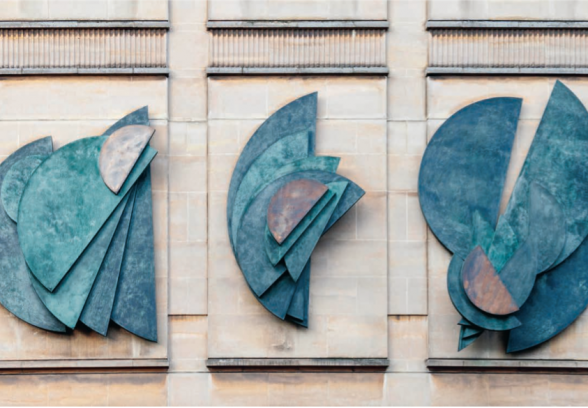This website uses cookies
This website uses cookies to enable it to function properly and to analyse how the website is used. Please click 'Close' to accept and continue using the website.



Barbara Hepworth’s ‘Theme and Variations’ on the Cheltenham and Gloucester Building Society HQ
The sculptor’s last commission has been listed – and so has the façade of the building for which she designed it
Cheltenham isn’t exactly a hotspot for C20 architecture, so news that the town is home to an unlisted Barbara Hepworth sculpture came as a slight surprise to us. As so often, it reached us with the further news that it was under threat.
Hepworth was approached by local architects Healing and Overbury in 1970, at a time when she had reached international fame and renown, although her health was seriously failing. Thomas Overbury asked for a sculpture to adorn their stripped-back neo-classical design for Cheltenham and Gloucester Building Society’s new HQ. The site presented a challenge to the architect and artist, as the street is laid out in a sustained curve and the character of the surrounding area is dominated by the Georgian terraces for which Cheltenham is best known.
Hepworth’s design was for three groups of layered bronze semicircles that used the curve of the building’s façade to create a sense of movement and interplay between the individual ‘leaves’ when viewed when walking along the street. A variety of surface textures and patina was achieved during casting at the Morris Singer foundry, and the bronze hues are also picked up in the building’s slate window surrounds.
‘Theme and Variations’ was the last commission Hepworth undertook, and is one of a small number of pieces she designed to be attached to a building, rather than standing alone or in a landscape setting. At the unveiling in 1972, Duncan James wrote that Hepworth’s rare architectural commissions ‘have resulted in key productions, sculptures that might be regarded as milestones in her development as an artist’. The use of simple geometry is unusual for Hepworth, and the piece is representative of her late works aimed at the international market, only a small number of which are on display in the UK.
The building society moved out of Cheltenham House in 1989, and the sculpture is now owned by a property investment firm. In August this year Cheltenham Borough Council were notified of the owners’ intention to remove the sculpture. The Council had previously refused an application for removal in 1988, so the current owners sought a Certificate of Proposed Lawful Development instead, arguing that if ‘Theme and Variations’ were replaced with a replica there would be no change to the appearance of Cheltenham House, meaning planning permission would not be required.
The Society has seen a number of cases of public art being removed and sold, so we are well aware of the risks, especially once owners know a listing assessment is underway. A potential fine from the local authority for unlawful removal was likely to pale in comparison to the value of the work on the open market. We quickly submitted a listing application including information provided by Sophie Bowness of the Hepworth Trust, and also requested that Cheltenham Borough Council issue a Building Preservation Notice to offer interim protection before a listing decision was reached. BPNs are very useful but sadly underused, as Councils are liable for damages if listing is refused. We were very pleased that the council responded positively to our request and, thankfully, the threat of removal was temporarily lifted. The good news continued when Historic England listed both the sculpture and the curved principal façade of Cheltenham House at Grade II in October.
The success was tinged with concern about what the owners’ legal advice meant for other unlisted pieces of public art around the country. Cheltenham’s response to the owners’ application for a Certificate of Proposed Lawful Development was issued after the sculpture was listed, so it offers no conclusive answer to this question. The Planning Officer did cast doubt over how faithful a replica would actually be, implying that the request would have been refused even if the sculpture remained unlisted. We are really pleased that the contribution this post-war addition makes to Cheltenham’s historic character has been fairly recognised, both formally by the local authority and through listing, but also by local people, especially by the local Councillor who sent us the initial tip-off.
Grace Etherington

Become a C20 member today and help save our modern design heritage.